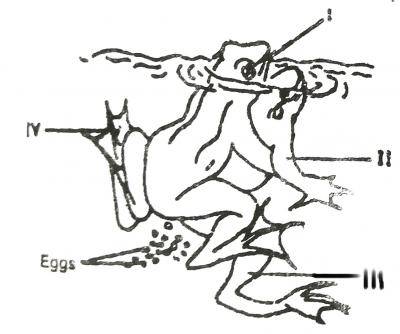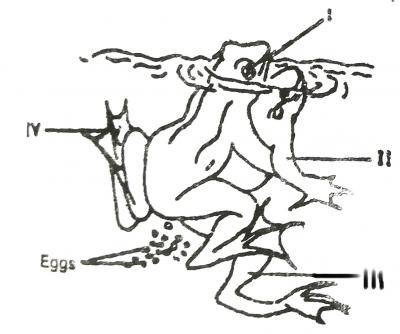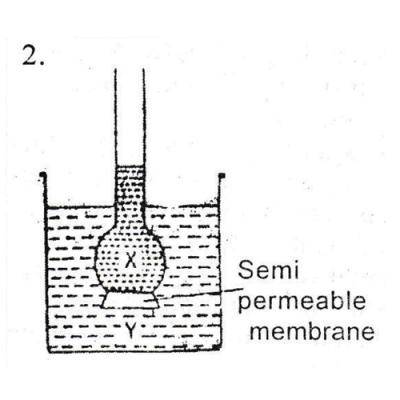26. Which of the following organisms is a primary consumer?
A. dog
B. sheep
C. grass
D. fungus
Correct Answer: Option B
27. Study the diagram of a food chain shown and use; it to answer the question.
P ---> Q ---> R ---> S ---> T
The organism designated P in the food chain above is normally sustained by energy from
A. sunlight
B. carbohydrates
C. green plants
D. mineral salts
Correct Answer: Option A
28. Study the diagram of a food chain shown and use; it to answer the question.
P ---> Q ---> R ---> S ---> T
Which of the following statements best describes the organism designated R? It
A. feeds on S
B. is a primary consumer
C. is a producer as well as a consumer
D. is a secondary consumer
Correct Answer: Option D
29. Which of the following diseases is not hereditary?
A. Albinism
B. Scabies
C. Haemophilla
D. Colour blindness
Correct Answer: Option B
30. The immediate product of meiosis in flowering plants is the
A. sporophyte
B. gametophyte
C. zygote
D. pollen grains
Correct Answer: Option D
31. DNA in eukaryotic cells is contained in the
A. central vacuole
B. nucleus
C. lysosome
D. golgi body
Correct Answer: Option B
32. A man who is heterozygous for the disease haemophilia marries a woman who is double recessive for haemophilia. What percentage of their offspring would have the disease?
A. 0%
B. 25%
C. 50%
D. 75%
Correct Answer: Option C
33. Cytokinesis of mitosis is a process that ensures that
A. each daughter cell gets the necessary organelles
B. there is distribution of a complete set of genes into each daughter cell
C. daughter cell inherit new genetic combinations
D. worn out organelles are excluded from daughter cells
Correct Answer: Option B
34. An animal which is active during the day is known as a
A. nocturnal animal
B. diurnal animal
C. terrestrial animal
D. homortacmic animal
Correct Answer: Option B
35.Evidence of evolution include the following except
A. fossil records
B. comparative anatomy
C. mutation of genes
D. geographical distribution of organisms
Correct Answer: Option C
36

Use the diagram to answer the question. The diagram shows that the organisms are
A. hermaphrodite
B. viviparous
C. oviparous
D. ovoviparous
Correct Answer: Option C
37

Use the diagram to answer the question. The breeding posture illustrated in the diagram is knows as
A. mating
B. amplexus
C. courtship display
D. reproductive swimming
Correct Answer: Option B
Explanation
Amplexus is the term used to describe the mating process of toads and frogs.
38. An accurate identification of a rapist can be carried out by conducting
A. RNA analysis
B. DNA analysis
C. blood group test
D. behavioural tests
Correct Answer: Option B
39. A boy who is fond of swimming in a pond finds himself passing urine with traces of blood. He is like to have contracted?
A. schistosomiasis
B. onchocerciasis
C. poliomyelitis
D. salmonellosis
Correct Answer: Option A
40. The flippers of a whale and the fins of a fish are examples of
A. divergent evolution
B. co-evolution
C. continuous variation
D. convergent evolution
Correct Answer: Option D
41. According to James, when we meet various trials in life, we should_____________
A. rejoice because the Lord is good
B. bless God’s name
C. count it all Joy
D. call upon the name of the Lord
Correct Answer: Option C
Explanation
"My brethren, count it all joy when ye fall into divers temptations; " (James 1:2)
42. The yellowish colored liquid component of blood that normally holds the blood cells in suspension is
A. serum
B. plasma
C. water
D. thrombocyte
Correct Answer: Option B
Explanation
Blood plasma is a yellowish colored liquid component of blood that normally holds the blood cells in whole blood in suspension; this makes plasma the extracellular matrix of blood cells. It makes up about 55% of the body's total blood volume.
blood plasma is a light yellow liquid, similar to the color of straw. Along with water, plasma carries salts and enzymes. The primary purpose of plasma is to transport nutrients, hormones, and proteins to the parts of the body that need it
43.The function of pith in plant is
A. Absorb mineral salt and nutrient from the soil
B. Pith, or medulla, is a tissue in the stems of vascular plants. Pith is composed of soft, spongy parenchyma cells, which store and transport nutrients throughout the plant.
C. trap chlorophyll from the sunlight
D. Removal of waste product from the plant
Correct Answer: Option C
Explanation
trap chlorophyll from the sunlight
44. A pollutant that is mostly associated with acid rain is
A. Nitrogen (IV) oxide
B. Ozone
C. Flourine
D. Carbony (IV) oxide
Correct Answer: Option A
Explanation
The main chemicals in air pollution that create acid rain are sulfur dioxide (SO2) and nitrogen (NOx). Acid rain usually forms high in the clouds where sulfur dioxide and nitrogen oxides react with water, oxygen, and oxidants. This mixture forms a mild solution of sulfuric acid and nitric acid.
Nitrogen dioxide and nitric oxide are referred to together as oxides of nitrogen (NOx). NOx gases react to form smog and acid rain
45. What is the function of contractile vacuole in paramecium?
A. Produces Enzymes
B. Gets rid of excreta
C. Stores and digest food
D. Gets rid of excess water
Correct Answer: Option D
Explanation
Osmoregulation. Paramecium and amoeba live in fresh water. Their cytoplasm contains a greater concentration of solutes than their surroundings and so they absorb water by osmosis. The excess water is collected into a contractile vacuole which swells and finally expels water through an opening in the cell membrane.
: Excretion of water in Paramecium is carried out by the Contractile vacuoles
46. An organism which exhibit extracellular digestion is
A. Spirogyra
B. Paramecium
C. Amoeba
D. Rhizopus
Correct Answer: Option D
Explanation
Extracellular digestion is a process in which saprobionts feed by secreting enzymes through the cell membrane onto the food. The enzymes catalyze the digestion of the food into molecules small enough to be taken up by passive diffusion, transport, or phagocytosis. Rhizopus use extracellular digestion.
47. How many days does is used for incubation of an egg to release chick
A. 21
B. 22
C. 20
D. 23
Correct Answer: Option A
Explanation
On the 21st day of incubation the chick finishes its escape from the shell. The initial break in the shell is made by the egg tooth. This is referred to as external pipping
48. The four classes of cnidarian include the following except
A. Turbellaria
B. Anthozoa
C. Scyphozoa
D. cubozoa
Correct Answer: Option A
Explanation
Modern cnidarians are generally classified into four main classes: sessile Anthozoa (sea anemones, corals, sea pens); swimming Scyphozoa (jellyfish) and Cubozoa (box jellies); and Hydrozoa
Turbellaria are one of the traditional sub-divisions of the phylum Platyhelminthes (flatworms)
49

What would happen if solution Y is more concentrated than solution X in fig 2
A. The level of X would rise, Y would falls
A. The level of X would rise, Y would rise
C. The level of X and Y stands the same
D. The level of Y would rise, X would fall.
Correct Answer: Option D
Explanation
Osmosis is the spontaneous net movement of solvent molecules through a selectively permeable membrane into a region of higher solute concentration, in the direction that tends to equalize the solute concentrations on the two sides Therefore, the level of Y (region of higher concentration) would rise, X (region of lower concentration) would fall to equalize the solute concentrations on the two sides
This explain osmosis
50. Physiological adaptation to very dry conditions in animal demonstrates
A. Xeromorphism
B. Hibernation
C. Aestivation
D. Rejuvenation
Correct Answer: Option B
Explanation
Xeromorphic describe the structural modifications of certain plants (xerophytes) that enable them to reduce water loss, particularly from their leaves and stems.
Hibernation is a state of inactivity and metabolic depression in endotherms. Hibernation refers to a season of heterothermy characterized by low body temperature, slow breathing and heart rate, and low metabolic rate








No comments: